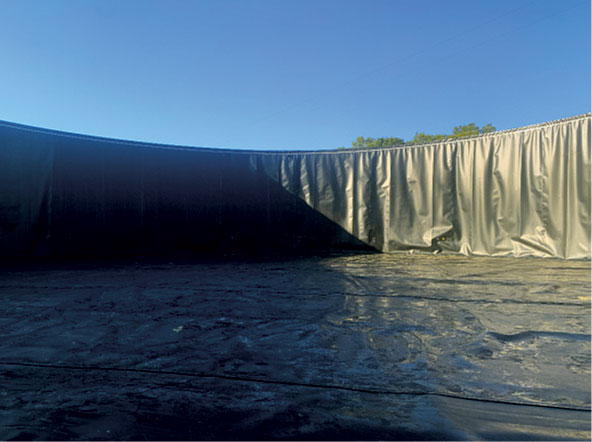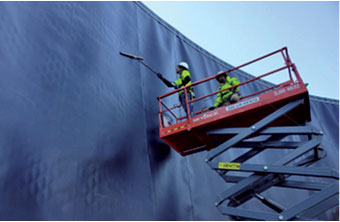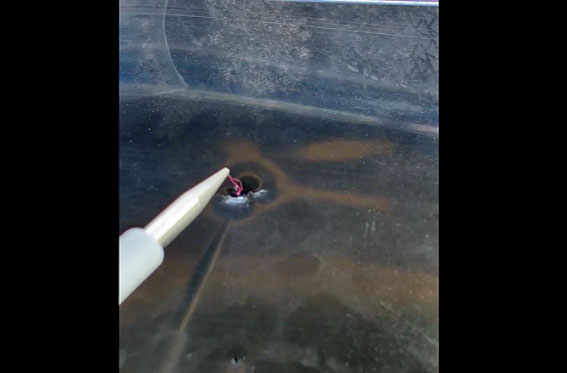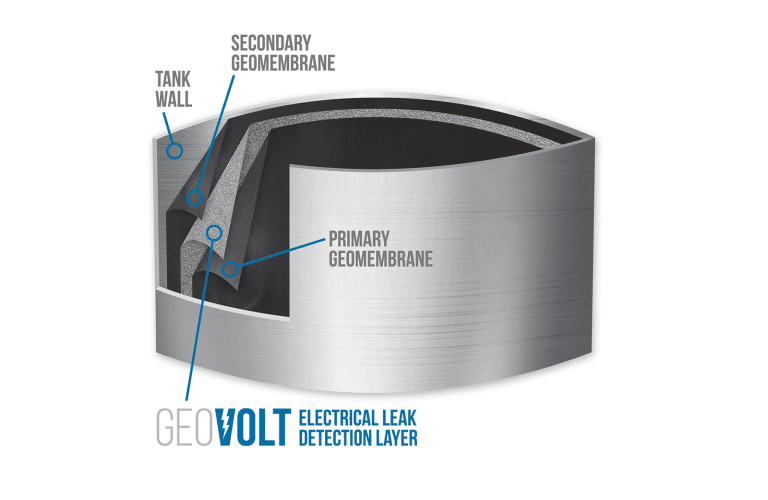Background
Chesapeake Containment Systems (CCS) was awarded the supply and installation of a 150′ diameter and 32′ high Above Wall Storage System (AWSS). An 80 mil thick High Density Polyethylene (HDPE) primary and secondary geomembrane were selected to line the steel walls and bottom of the tank. The wastewater contained a variety of organic and inorganic compounds. As part of the project scope, CCS was asked by the facility owner to perform Electrical Leak Location (ELL) testing on the primary geomembrane. The ELL method accurately locates leaks in a geomembrane-lined impoundment. This field-proven method has located many leaks that were not previously found using conventional QA/QC techniques.
Solution
CCS contacted Layfield to enquire about our Geovolt® conductive composite, a leak detection composite. The double lined tank required a conductive medium between the primary and secondary geomembrane. ELL testing was performed on the primary geomembrane using Geovolt® as the conductive layer between the primary and secondary geomembrane.
Electrical Leak Location Testing: Conventional ELL testing requires wetting of the substrate under the geomembrane to build the required conductivity for testing. Transporting water to wet the substrate (geotextile/subgrade) can be costly and logistically challenging. Geovolt® was selected because it provides continuous conductivity under the primary geomembrane and does not require wetting the surface. Geovolt® product is discussed in the next section under “ELL testing using Geovolt®.”
Installation
Chesapeake Containment Systems requested that BLE identify potential leaks (if any) in the exposed 80 mil HDPE primary geomembrane liner using ELL services. BLE performed the ELL services on the exposed 80 mil HDPE primary geomembrane using the Arc Testing Method (ASTM D7953).
A scissor lift was used to assist the ELL personnel in testing the entire wall area of the tank. During the ELL survey, weather temperatures ranged from approximately 60°F to 75°F, with sunny skies. Prior to the ELL testing in the tank, a leak detection sensitivity test was performed on a separate portion of liner material located inside the tank. The leak detection sensitivity test was performed to calibrate the equipment to the on-site conditions and to confirm that the equipment was functioning properly.
A visible arc formed between the wand and the exposed liner at the puncture, and an audio signal was heard from the test equipment (AP-W High Voltage Holiday Detector), confirming the proper functioning of the equipment. The ELL in the survey area was performed by utilizing the settings established from the sensitivity test, applying a high DC voltage to a test wand above the exposed primary geomembrane liner surface, and grounding the test equipment to the subgrade soils outside of the tank.
BLE’s ELL technician performed the survey on the wall and floor area of the double lined tank. The wall area was tested to the top of the tank using 3-foot-wide passes. Each subsequent pass overlapped the previous pass by approximately 3 inches to ensure that all the exposed liner was surveyed. The same procedures were used for the ELL testing performed over the entire floor area. During ELL testing, one defect (puncture) was detected on the primary geomembrane liner of the tank. The defect was located on the wall area of the tank, approximately 15 feet up from the tank’s floor and 1 foot left of the welded seam.
Result
Geovolt® leak detection geosynthetic provided peace of mind to the Owner as it guaranteed the integrity of the system for leaks. In this application, Geovolt® served both as a conductive layer and a drainage medium between the two geomembranes. Using a traditional geotextile would require large amounts of water to wet the geotextile before ELL testing. The excess water remaining in the leak detection zone must be removed before filling the tank, incurring additional costs to the Owner.
Electrical Leak Location testing using Geovolt® conductive composite: Geovolt® is a conductive composite that combines a thin conductive film with a needle-punched nonwoven geotextile. This unique manufacturing process creates a consistent conductive material that can facilitate effective electric leak detection under most geomembranes. The nonwoven laminate allows the material to double as a cushion layer. Geovolt™ was developed specifically to address several challenges currently faced when deploying electric leak location methods, including:
- No need for water above the geomembrane
- Consistent conduction of electricity beneath the entire lined surface
- No need for special welding techniques
- Can be used with any synthetic waterproofing barrier
GeoVolt™ is patented in North America and meets the requirements of ASTM D7852, which is “Standard Practice for the use of an Electrically Conductive Geotextile for Leak Location Surveys.”
PROJECT PARTNERS: Layfield Geosynthetics, Bunnell-Lammons Engineering (ELL Contractor), Chesapeake Containment Systems (Liner Contractor)



